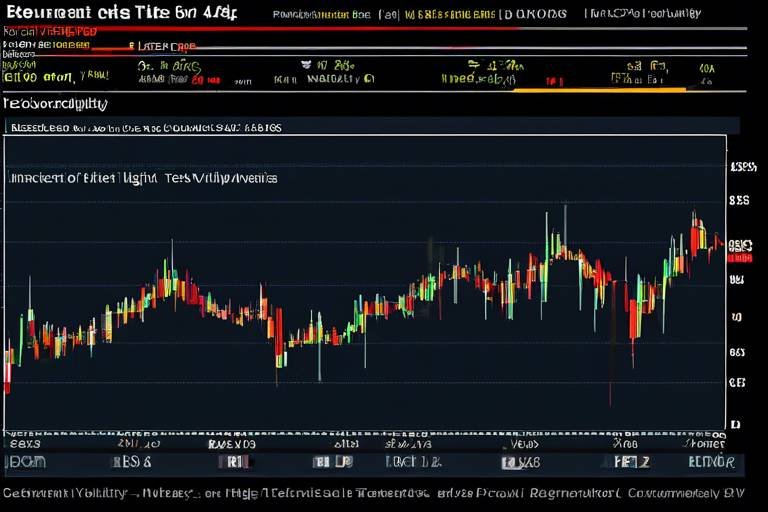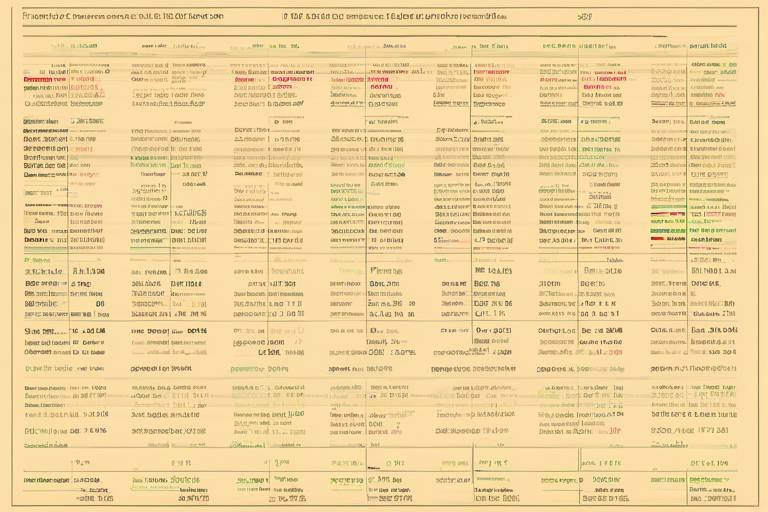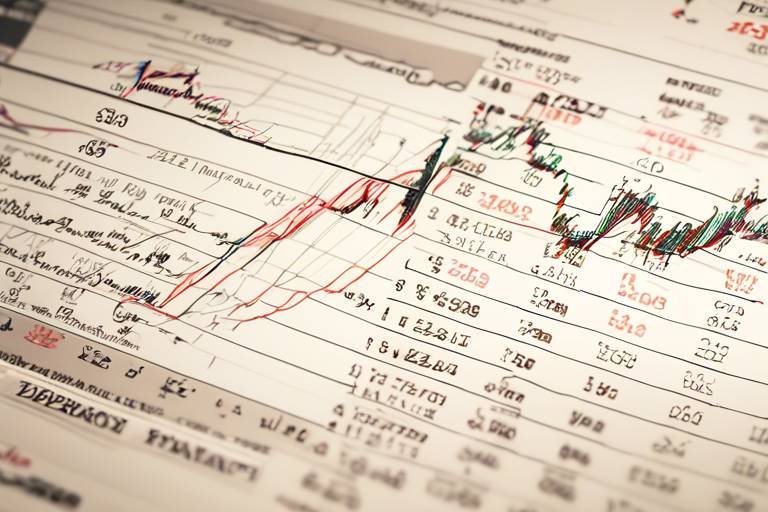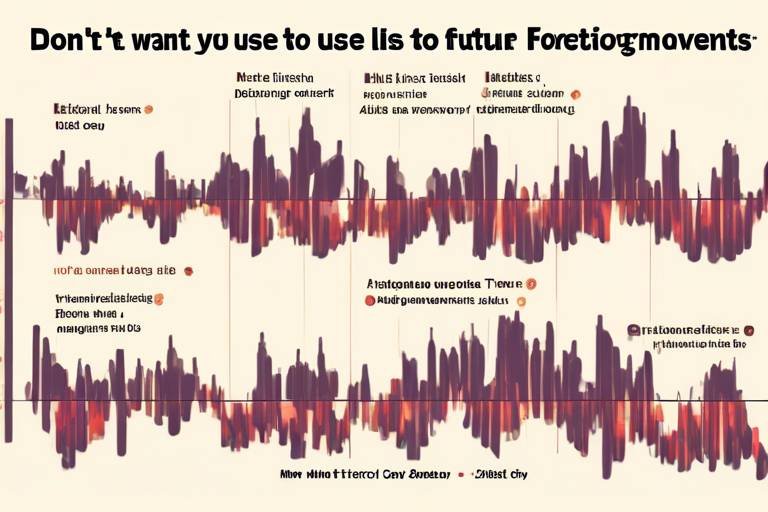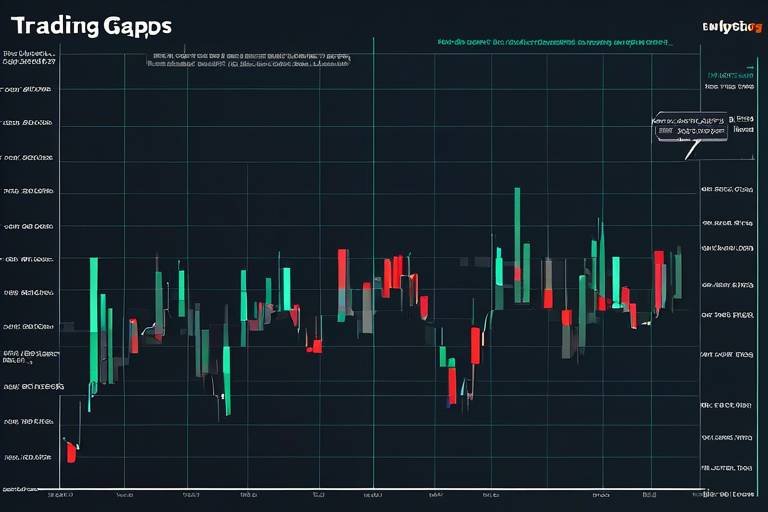The Impact of High Volatility on Technical Analysis
High volatility in the financial markets can feel like riding a roller coaster—exciting yet terrifying. As prices swing dramatically within short time frames, traders and investors must adapt their strategies to navigate these turbulent waters. This article explores how high volatility influences technical analysis, affecting trading strategies, market behavior, and decision-making processes for traders and investors in fluctuating markets. Understanding this phenomenon is crucial for anyone looking to enhance their trading acumen and make informed decisions in a rapidly changing environment.
High volatility refers to significant price fluctuations within a short time frame. These fluctuations can be triggered by various factors, including economic news releases, geopolitical events, and changes in market sentiment. When volatility spikes, it can lead to opportunities for profit, but it also increases the risk of losses. For market participants, this means that their trading strategies must be flexible and responsive to the changing conditions. Traders often find themselves asking, "How can I capitalize on this volatility without exposing myself to undue risk?"
The implications of high volatility extend beyond mere price movements. They can affect market liquidity, slippage, and the overall psychology of traders. When volatility is high, traders may experience heightened emotions, leading to impulsive decisions that can further exacerbate market swings. Understanding these dynamics is essential for developing a robust trading strategy that can withstand the pressures of a volatile market.
Technical indicators are essential tools for traders seeking to make sense of price movements. However, high volatility can significantly impact the effectiveness of these indicators. For example, moving averages, the Relative Strength Index (RSI), and Bollinger Bands may not provide the same level of insight in a volatile environment as they do in stable conditions. This section delves into the nuances of how high volatility alters the reliability of these indicators and how traders can adapt their strategies accordingly.
Moving averages smooth price data to identify trends. In volatile markets, their reliability can diminish, leading to potential misinterpretations and false signals for traders. For instance, a short-term moving average might react too quickly to price changes, resulting in whipsaw effects where traders are misled into making trades that are not aligned with the broader market trend.
Short-term moving averages are like a quick reflex, responding rapidly to price changes, while long-term averages provide a more stable view of the market's direction. In high volatility scenarios, short-term averages can generate numerous false signals, while long-term averages may lag behind actual price movements. Understanding the balance between these two types of averages is crucial for traders looking to make informed decisions.
Adaptive moving averages adjust their sensitivity based on market conditions. This adaptability can be particularly beneficial during periods of high volatility, as they provide a more accurate reflection of current price trends. Traders who utilize adaptive moving averages can gain an edge, as these indicators can help filter out noise and highlight genuine market movements.
The RSI is a popular tool that helps traders identify overbought or oversold conditions. However, during periods of high volatility, the RSI can become distorted, leading to misleading signals. For example, a stock might appear overbought due to a sudden price spike, but that doesn't necessarily mean a reversal is imminent. Traders must exercise caution and consider additional factors before making decisions based solely on RSI readings.
Market psychology plays a crucial role in trading decisions. High volatility can significantly affect trader sentiment and behavior, leading to dramatic shifts in market trends. When prices fluctuate wildly, traders often find themselves caught in a whirlwind of emotions, oscillating between fear and greed. This emotional roller coaster can cloud judgment and lead to impulsive trading decisions.
Fear and greed are powerful emotions in trading. In high volatility situations, these emotions can amplify, causing traders to make rash decisions. For instance, a sudden price drop may trigger fear, prompting traders to sell off their positions hastily, while a rapid price increase can incite greed, leading to overexposure in the market. Understanding these emotional dynamics is crucial for traders aiming to maintain a disciplined approach in the face of volatility.
Investor behavior can shift dramatically in volatile markets. During periods of high volatility, traders may exhibit herd behavior, following the crowd rather than relying on their analysis. This can lead to exacerbated market swings and create opportunities for savvy traders who can identify and capitalize on these patterns. Recognizing common behavioral trends during volatility can help traders make more informed decisions and avoid pitfalls.
Adapting trading strategies is essential in high volatility environments. Traders must be proactive and flexible, employing effective strategies and risk management techniques to navigate these turbulent markets successfully. Below are some strategies that can be particularly beneficial:
Scalping involves making quick trades to capitalize on small price movements. In high volatility markets, scalping can enhance opportunities, as rapid price changes create more chances for profit. However, the associated risks are also higher, and traders must be prepared to react swiftly to avoid significant losses.
Stop-loss orders are vital for risk management. In high volatility conditions, effectively utilizing stop-loss orders can protect investments from significant losses. Traders should consider setting tighter stop-loss levels to account for the increased price swings, ensuring they can exit positions before incurring substantial losses.
- What is high volatility? High volatility refers to significant price fluctuations in a short period, often driven by market news, events, or sentiment shifts.
- How does high volatility affect trading strategies? High volatility can lead to increased risks and opportunities, requiring traders to adapt their strategies and utilize effective risk management techniques.
- What are some effective indicators in volatile markets? Indicators like adaptive moving averages and the RSI can be used, but traders should be cautious of false signals during high volatility.
- How can emotions impact trading decisions in volatile markets? Emotions like fear and greed can lead to impulsive decisions, making it essential for traders to maintain discipline and a clear strategy.

Understanding High Volatility
High volatility refers to significant price fluctuations within a short time frame, and it can dramatically change the landscape of trading. Imagine a rollercoaster ride where the highs are exhilarating, but the lows can be terrifying. In the financial markets, this volatility can be caused by various factors, such as economic news, geopolitical events, or even market sentiment. When traders and investors see prices swinging wildly, it can create both opportunities and challenges.
One of the most notable implications of high volatility is its effect on trading strategies. Traders often rely on specific patterns and indicators to make informed decisions. However, in a volatile market, these indicators can become unreliable. For instance, a stock that typically follows a predictable pattern may suddenly behave erratically, leading to potential losses for those who are not prepared. This unpredictability can leave even seasoned traders feeling perplexed and uncertain.
Moreover, high volatility can lead to increased trading volume. When prices move sharply, it often attracts more traders looking to capitalize on these changes. This influx can further exacerbate price swings, creating a feedback loop of heightened activity. It's like a snowball effect—once it starts rolling, it gathers speed and size, making it even harder to predict where it will end up.
Understanding the causes of high volatility is crucial for traders who want to navigate these turbulent waters effectively. Some common causes include:
- Economic Reports: Announcements like employment data or GDP growth can send shockwaves through the market.
- Geopolitical Events: Tensions between countries or unexpected political changes can create uncertainty.
- Market Sentiment: The collective mood of investors can shift quickly, influencing buying and selling behaviors.
As traders, recognizing these factors can help in adjusting strategies to mitigate risks. It's essential to stay informed and be ready to adapt. High volatility can also create opportunities for profit, but it requires a keen eye and quick decision-making. Just like a surfer riding a big wave, one must be able to balance the thrill of the ride with the potential dangers lurking beneath the surface.
In conclusion, understanding high volatility is not just about recognizing price movements; it's about grasping the underlying factors that drive those movements. By doing so, traders can better prepare themselves for the challenges and opportunities that come with fluctuating markets. As we delve deeper into how this volatility impacts technical analysis, it's vital to keep in mind that knowledge is power in the ever-changing world of trading.

The Role of Technical Indicators
Technical indicators are the bread and butter of many traders, acting as vital tools that help decode the language of price movements in the market. When it comes to high volatility, the role of these indicators becomes even more critical yet complex. In fluctuating markets, traders often rely on a variety of indicators to make informed decisions, but the question arises: how does high volatility impact the effectiveness of these tools? Understanding this relationship can be the key to navigating the stormy seas of trading.
High volatility can lead to rapid price changes, which may render traditional indicators less reliable. For instance, indicators like moving averages, the Relative Strength Index (RSI), and Bollinger Bands are designed to smooth out price data and identify trends. However, in a highly volatile environment, these indicators might produce false signals, misleading traders into making poor decisions. Imagine trying to read a map during a storm; the constant changes in your surroundings can make it hard to find your way. Similarly, in trading, the noise created by volatility can drown out the signals that indicators are trying to convey.
Let’s take a closer look at some of the most commonly used technical indicators and how they are affected by high volatility:
| Indicator | Impact of High Volatility | Considerations for Traders |
|---|---|---|
| Moving Averages | Can lag behind price movements, leading to late signals. | Consider using shorter time frames for quick responses. |
| Relative Strength Index (RSI) | May show overbought/oversold conditions too frequently. | Look for confirmation from other indicators. |
| Bollinger Bands | Wider bands can signal increased volatility, but can also trap traders. | Use in conjunction with price action for better clarity. |
As we can see from the table, each indicator has its own quirks when faced with high volatility. For example, moving averages can become less reliable as the rapid price changes can lead to misinterpretations. Traders might find themselves chasing trends that are not sustainable, akin to trying to catch a wave that keeps crashing back down. On the other hand, the RSI, which is designed to indicate overbought or oversold conditions, can generate misleading signals when volatility spikes. This can lead to traders entering or exiting positions at the wrong time, akin to jumping off a diving board without checking the water first.
In high volatility conditions, it’s not just about the indicators themselves but also how traders interpret them. Context is everything. For instance, during a market crash, a stock may appear oversold according to the RSI, but that doesn’t mean it’s a good buy; it could continue to fall further. Thus, traders must combine their technical analysis with a keen awareness of market conditions and sentiment.
In summary, while technical indicators are essential for traders, their effectiveness can be compromised in high volatility. Traders need to remain vigilant, adapt their strategies, and consider the broader market context when using these tools. By doing so, they can improve their chances of making sound trading decisions, even when the market feels like a rollercoaster ride.

Moving Averages
Moving averages are one of the most widely used technical indicators in the trading world, serving as a fundamental tool for traders trying to identify trends and make informed decisions. They work by smoothing out price data over a specified period, allowing traders to see the overall direction of the market without being overly influenced by short-term fluctuations. However, when it comes to high volatility markets, the effectiveness of moving averages can take a hit. Imagine trying to read a book in a room where the lights keep flickering; that’s what trading with traditional moving averages feels like during volatile times. The constant price swings can lead to misinterpretations and false signals, leaving traders second-guessing their strategies.
In high volatility scenarios, moving averages can become less reliable. For instance, if a trader is using a simple moving average (SMA), they might find that the average is lagging behind the actual price action. This lag can result in delayed entries and exits, which can be detrimental in fast-moving markets. Conversely, a trader using an exponential moving average (EMA), which gives more weight to recent prices, may react more quickly to price changes. However, this increased sensitivity can also lead to whipsaws—false signals that can cause losses if not managed properly.
To illustrate the differences in performance between short-term and long-term moving averages during high volatility, consider the following table:
| Type of Moving Average | Characteristics | Performance in High Volatility |
|---|---|---|
| Short-Term Moving Average (e.g., 10-day) | Responds quickly to price changes | Can generate false signals, leading to potential losses |
| Long-Term Moving Average (e.g., 50-day) | Provides a smoother trend line | May lag behind actual price action, resulting in missed opportunities |
In conclusion, while moving averages are invaluable tools for traders, their effectiveness can be compromised in high volatility markets. Understanding the nuances between different types of moving averages—like short-term versus long-term—can help traders make more informed decisions. Additionally, employing adaptive moving averages, which adjust their sensitivity based on market conditions, can be a game-changer for navigating the choppy waters of volatility. These adaptive tools allow traders to remain flexible and responsive, enhancing their ability to capitalize on market movements without falling prey to the pitfalls of traditional moving averages.

Short-Term vs. Long-Term Averages
When it comes to understanding market movements, the distinction between short-term and long-term moving averages is crucial, especially in the context of high volatility. Short-term moving averages, such as the 5-day or 10-day averages, are designed to react quickly to price changes. They can be incredibly useful in capturing rapid price movements, making them ideal for traders looking to capitalize on quick gains. However, their sensitivity can also lead to false signals. For instance, in a highly volatile market, a short-term average might suggest a bullish trend when, in reality, the price is merely experiencing a temporary spike. This can mislead traders into making hasty decisions that could result in losses.
On the other hand, long-term moving averages, like the 50-day or 200-day averages, provide a broader view of market trends. They smooth out short-term fluctuations and help traders identify the overall direction of the market. In times of high volatility, these averages can serve as a stabilizing force, offering insights into the underlying trend. However, the downside is that they react more slowly to price changes, which can cause traders to miss out on immediate opportunities. For example, while a long-term average might confirm a strong upward trend, it may lag behind the actual market movement, leading to missed entry points.
To illustrate this further, consider the following table that compares the characteristics of short-term and long-term moving averages:
| Characteristic | Short-Term Averages | Long-Term Averages |
|---|---|---|
| Reaction Speed | Fast | Slow |
| Signal Reliability | Lower (more false signals) | Higher (more reliable) |
| Use Case | Day trading, quick trades | Trend analysis, long-term investments |
| Market Conditions | Volatile markets | Stable or trending markets |
In summary, while both short-term and long-term moving averages have their unique advantages and drawbacks, the key to successful trading in high volatility lies in understanding when to utilize each type. Savvy traders often employ a combination of both to create a more comprehensive trading strategy. By using short-term averages to identify immediate opportunities and long-term averages to confirm the overall trend, traders can navigate the choppy waters of high volatility with greater confidence.
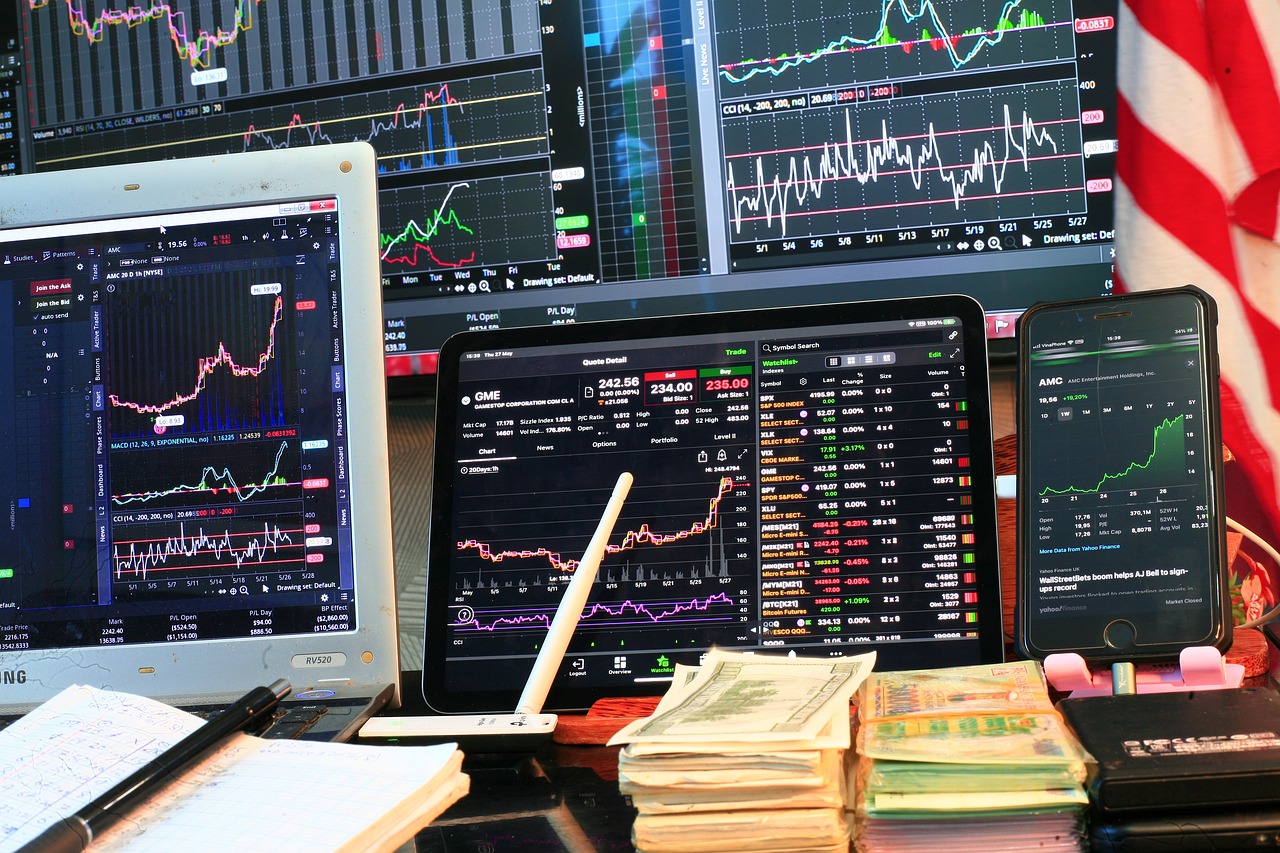
Adaptive Moving Averages
When navigating the tumultuous seas of high volatility, traders often find themselves in a precarious position, where traditional tools may falter. This is where come into play. Unlike standard moving averages that maintain a consistent calculation period, adaptive moving averages dynamically adjust their sensitivity based on market conditions. This adaptability allows traders to respond more effectively to rapid price changes, making them a valuable asset in the ever-shifting landscape of volatile markets.
Imagine you’re trying to follow a fast-moving train. A standard moving average is like a fixed camera that captures a stationary view of the train, while an adaptive moving average is akin to a moving camera that adjusts its focus as the train speeds up or slows down. This metaphor illustrates how adaptive moving averages can provide a clearer picture of market trends during periods of high volatility.
In practice, adaptive moving averages can be calculated using various methods, such as the Adaptive Exponential Moving Average (AEMA) or the Variable Length Moving Average (VLMA). Each of these methods has its own unique way of adjusting the sensitivity, often incorporating factors like price volatility and trading volume. For instance, the AEMA places more weight on recent price movements, allowing it to react swiftly to sudden market shifts, while the VLMA adjusts its length based on the volatility of the asset being analyzed.
To illustrate the effectiveness of adaptive moving averages, consider the following table that compares their performance against traditional moving averages in a high volatility scenario:
| Indicator Type | Responsiveness | Signal Accuracy | Risk of False Signals |
|---|---|---|---|
| Traditional Moving Average | Low | Moderate | High |
| Adaptive Moving Average | High | High | Low |
As the table shows, adaptive moving averages tend to outperform traditional moving averages in terms of responsiveness and signal accuracy, particularly when the market is experiencing significant fluctuations. This enhanced performance can be a game changer for traders who need to make quick decisions based on the latest market data.
However, it’s essential to keep in mind that while adaptive moving averages offer significant advantages, they are not infallible. Traders should combine them with other technical indicators and fundamental analysis to create a more comprehensive trading strategy. This holistic approach can help mitigate risks associated with reliance on a single indicator, especially in unpredictable market conditions.
In conclusion, adaptive moving averages provide traders with a powerful tool to navigate the complexities of high volatility. By adjusting their sensitivity based on market dynamics, these indicators can help traders identify trends more accurately and make informed decisions, ultimately enhancing their trading strategies in fluctuating markets.

Relative Strength Index (RSI)
The is a popular momentum oscillator that measures the speed and change of price movements. Traders use it to identify overbought or oversold conditions in a market, providing valuable insights into potential price reversals. However, in the realm of high volatility, the reliability of the RSI can be significantly compromised. When markets experience rapid price swings, the RSI can generate misleading signals, causing traders to make ill-informed decisions.
In a stable market, the RSI typically oscillates between 0 and 100, with readings above 70 indicating an overbought condition and those below 30 suggesting an oversold condition. Yet, during periods of high volatility, these thresholds can become less reliable. For instance, a stock might remain overbought for an extended period due to strong bullish sentiment, or it could be oversold yet continue to decline as panic selling takes hold. This phenomenon makes it crucial for traders to understand the context in which they're interpreting RSI values.
Moreover, the RSI's default settings, which are often set to a 14-day period, may not be suitable for volatile markets. Traders may need to adjust their settings to better reflect the rapid price changes. A shorter period could provide a more sensitive reading, capturing the swift movements, but it may also lead to increased false signals. Conversely, a longer period might smooth out the volatility but could result in delayed entries and exits, missing out on lucrative opportunities.
To illustrate the impact of high volatility on RSI, consider the following table:
| Market Condition | RSI Reading | Interpretation |
|---|---|---|
| Stable Market | 75 | Overbought – Potential reversal |
| High Volatility – Bullish Trend | 85 | Still overbought, but may continue rising |
| High Volatility – Bearish Trend | 25 | Oversold – Potential reversal, but may continue to fall |
In conclusion, while the RSI is a powerful tool for traders, its effectiveness can be severely impacted during periods of high volatility. Traders must adapt their strategies, perhaps by incorporating additional indicators or adjusting the RSI settings to better suit the market conditions. By doing so, they can enhance their decision-making process and navigate the turbulent waters of volatile markets more effectively.
- What is the best RSI setting for volatile markets? - It often depends on the trader's strategy, but some traders prefer using shorter periods, such as 7 or 10 days, to capture rapid price movements.
- Can the RSI be used in conjunction with other indicators? - Absolutely! Many traders combine the RSI with other indicators like moving averages or MACD to confirm signals and improve accuracy.
- How does high volatility affect trading psychology? - High volatility can amplify emotions like fear and greed, leading to impulsive decisions. Being aware of this can help traders maintain discipline.

Market Psychology and Volatility
Market psychology is a fascinating and complex aspect of trading that significantly influences price movements. When we talk about high volatility, we are not just discussing erratic price swings; we are delving into the emotional rollercoaster that traders and investors experience during these turbulent times. Why do prices fluctuate so wildly? Often, it’s not just about the numbers on the charts; it’s about the collective mindset of market participants. In highly volatile markets, fear and greed can emerge as dominant emotions, driving traders to make impulsive decisions that can lead to significant gains or devastating losses.
During periods of high volatility, the sentiment in the market can shift rapidly. Traders may find themselves caught in a frenzy, driven by the fear of missing out (FOMO) on potential profits or the anxiety of losing their investments. This emotional turmoil can lead to irrational behaviors, such as panic selling or overzealous buying. For instance, when a stock price begins to plummet, the fear of further losses can trigger a mass exodus of investors, leading to a cascade effect that exacerbates the volatility. Conversely, when prices surge, the thrill of potential profits can lure in more traders, further inflating the bubble.
Understanding how these emotions manifest in the market is crucial for traders. It’s not just about analyzing charts or technical indicators; it’s about recognizing the psychological factors at play. For example, during high volatility, traders might experience:
- Panic Selling: This occurs when investors fear that prices will continue to fall, leading to a rush to sell off assets.
- Overtrading: In an attempt to capitalize on rapid price changes, traders may execute too many trades without careful consideration.
- Confirmation Bias: Traders may only seek information that supports their existing beliefs, ignoring contrary data that might suggest a different market direction.
Additionally, the impact of news and social media cannot be overstated. In today’s fast-paced digital age, rumors and headlines can spread like wildfire, influencing trader sentiment almost instantaneously. A single tweet can send stock prices soaring or crashing, highlighting the delicate balance between information and emotion in trading. As a result, traders must also be vigilant about the sources of their information and the potential for misinformation, especially in volatile environments.
Ultimately, recognizing the interplay between market psychology and volatility is essential for developing effective trading strategies. Traders who can maintain a level head and rely on sound analysis rather than emotional impulses are often better positioned to navigate the choppy waters of high volatility. It’s about finding that sweet spot between instinct and analysis, allowing emotional intelligence to guide decisions without overshadowing rational thought.
Q1: How does fear influence trading decisions during high volatility?
A1: Fear can lead to panic selling, where traders quickly exit positions to avoid further losses, often resulting in a downward spiral in prices.
Q2: What role does social media play in market psychology?
A2: Social media can rapidly disseminate information and rumors, influencing trader sentiment and leading to swift market reactions based on emotions rather than fundamentals.
Q3: Can understanding market psychology improve trading outcomes?
A3: Yes, traders who understand the psychological factors at play can make more informed decisions, avoiding impulsive actions driven by fear or greed.

Fear and Greed
When it comes to trading, are like two sides of the same coin, constantly flipping in high-volatility markets. These emotions can drive traders to make impulsive decisions, often leading to catastrophic results. You see, in times of uncertainty, fear can grip even the most seasoned investors, causing them to sell off assets at a loss just to escape the turmoil. On the flip side, the thrill of potential gains can ignite a greedy rush, pushing traders to take on excessive risks. This emotional rollercoaster can create a perfect storm for poor decision-making.
High volatility amplifies these emotions, making it crucial for traders to recognize their psychological triggers. For instance, when prices swing wildly, fear can lead to panic selling. Conversely, the allure of rapidly rising prices can make traders overly optimistic, encouraging them to hold onto losing positions in hopes of a rebound. It's almost like watching a thrilling movie where the plot twists keep you on the edge of your seat, but in the world of trading, the stakes are much higher.
To illustrate how fear and greed manifest in trading, consider the following scenarios:
- Panic Selling: When a stock suddenly drops 10% in a day, many traders may panic and sell, fearing further losses. This reaction can create a snowball effect, driving prices even lower.
- FOMO (Fear of Missing Out): If a cryptocurrency surges 50% overnight, traders may rush to invest without doing their homework, driven by the fear of missing the next big opportunity.
- Overconfidence: After a few successful trades, traders might become overly confident, believing they can predict market movements, which can lead to reckless decisions.
Understanding these emotional dynamics is essential for any trader looking to navigate volatile markets effectively. By recognizing when fear or greed is influencing their decisions, traders can implement strategies to mitigate these emotional responses. For example, setting strict trading rules, using stop-loss orders, and maintaining a diversified portfolio can help shield against the irrational impulses that high volatility can provoke.
Ultimately, mastering your emotions is just as important as mastering technical analysis. By balancing with a disciplined approach, traders can make more informed decisions and improve their chances of success in the unpredictable world of trading.
Q: How can I control my emotions while trading?
A: One effective way to manage emotions is by establishing a solid trading plan that includes clear entry and exit points. Additionally, practicing mindfulness and taking breaks can help maintain emotional balance.
Q: What role does market sentiment play in trading?
A: Market sentiment reflects the overall attitude of traders toward a particular market or asset. Understanding sentiment can provide insights into potential price movements, especially during periods of high volatility.
Q: Are there specific indicators to help gauge fear and greed?
A: Yes! Indicators like the Fear and Greed Index can provide insights into market sentiment. Additionally, analyzing volume spikes and market breadth can help identify shifts in trader psychology.

Investor Behavior
Investor behavior can shift dramatically in volatile markets, and understanding these changes is crucial for effective technical analysis. When prices are swinging wildly, emotions often take the front seat, driving decisions that might not align with sound trading strategies. In such an environment, you might see investors acting on impulse rather than logic, leading to a myriad of behavioral patterns.
During periods of high volatility, investors are more likely to experience what is commonly referred to as "herding behavior." This phenomenon occurs when individuals follow the crowd, often buying or selling based on the actions of others rather than their own analysis. For example, if a stock suddenly drops, many investors might panic and sell, fearing further losses, while others may see it as a buying opportunity. This creates a feedback loop that can exacerbate price movements, making the market even more volatile.
Additionally, high volatility can trigger a shift in risk tolerance among investors. Some may become more risk-averse, opting to liquidate positions to avoid potential losses, while others might become overly aggressive, seeking to capitalize on rapid price changes. This dichotomy can lead to unpredictable market behavior, where prices can swing dramatically in a very short time frame.
Moreover, cognitive biases play a significant role in how investors react to volatility. For instance, the availability heuristic can lead traders to overemphasize recent events, such as a sudden market drop, causing them to make decisions based on the most readily available information rather than a comprehensive analysis. Similarly, the confirmation bias can cause investors to seek out information that supports their existing beliefs, ignoring data that contradicts their views. This can result in poor decision-making, particularly in a volatile environment.
To sum it up, investor behavior in high volatility is characterized by:
- Emotional Responses: Fear and greed can cloud judgment.
- Herding Behavior: Following the crowd can lead to irrational trading.
- Shifts in Risk Tolerance: Investors may become more cautious or overly aggressive.
- Cognitive Biases: These can distort perception and lead to poor decisions.
Understanding these behavioral patterns is essential for traders looking to navigate volatile markets. By recognizing how emotions and biases can influence decision-making, investors can develop strategies that account for these psychological factors, ultimately leading to more informed trading choices.
Q1: How does high volatility affect investor behavior?
A1: High volatility often leads to emotional decision-making, where fear and greed can drive investors to act impulsively, resulting in erratic market behavior.
Q2: What is herding behavior in investing?
A2: Herding behavior occurs when investors follow the actions of others, often leading to mass buying or selling based on trends rather than individual analysis.
Q3: How can cognitive biases impact trading decisions?
A3: Cognitive biases can distort an investor's perception of the market, causing them to make decisions based on flawed reasoning or emotional responses rather than rational analysis.
Q4: What strategies can investors use to mitigate the effects of high volatility?
A4: Investors can employ strategies such as setting stop-loss orders, diversifying their portfolios, and maintaining a disciplined approach to trading to help manage the risks associated with high volatility.

Strategies for Trading in High Volatility
Trading in high volatility can feel like riding a roller coaster—exciting yet nerve-wracking! As prices swing wildly, it's crucial for traders to adapt their strategies to navigate these turbulent waters effectively. One of the most effective approaches is to employ scalping techniques. Scalping involves making quick trades to capitalize on small price movements. In a volatile market, these small fluctuations can happen frequently, providing numerous opportunities for profit. However, it's essential to remain vigilant, as the rapid pace of trading can lead to significant losses if not managed properly.
Another vital tool in a trader's arsenal during high volatility is the use of stop-loss orders. These orders allow traders to set predetermined exit points for their trades, helping to minimize potential losses. In a market that can turn on a dime, having a stop-loss in place acts like a safety net, ensuring that emotions do not cloud judgment. For example, if a trader buys a stock at $100, they might set a stop-loss order at $95. If the stock price drops to $95, the order is executed, limiting the loss to just $5 per share. This strategy is especially important in volatile conditions where prices can swing dramatically.
Moreover, position sizing becomes even more critical in high volatility. Traders must determine how much capital to risk on each trade, considering the increased likelihood of price swings. A common approach is to use a fixed percentage of their trading capital for each trade, ensuring that no single loss can significantly impact their overall portfolio. For instance, if a trader has a $10,000 account and decides to risk 2% per trade, they would only risk $200 on any given trade, allowing them to endure several losses without devastating their account.
Additionally, employing technical analysis can provide valuable insights into market trends and potential reversal points. In high volatility, traders should pay close attention to key support and resistance levels, as these can act as psychological barriers for market participants. When prices approach these levels, traders often see increased buying or selling pressure, which can lead to significant price movements. Utilizing tools such as Bollinger Bands can also help traders gauge market volatility and identify potential entry and exit points.
Finally, it's essential for traders to maintain a cool head and stick to their trading plan. High volatility can evoke strong emotions, leading to impulsive decisions. Establishing a clear trading strategy that includes entry and exit points, risk management techniques, and profit targets can help traders stay disciplined, even when the market feels chaotic. Remember, successful trading is not just about making profits but also about managing risks effectively.
In summary, trading in high volatility requires a blend of strategies, including scalping, using stop-loss orders, proper position sizing, technical analysis, and emotional discipline. By adapting to the fast-paced nature of volatile markets, traders can seize opportunities while minimizing risks.
- What is high volatility?
High volatility refers to significant price fluctuations in a short time, indicating uncertainty in the market. - How can I manage risks in a volatile market?
Using stop-loss orders, proper position sizing, and having a clear trading plan are effective risk management techniques. - Are scalping strategies effective in high volatility?
Yes, scalping can be very effective during high volatility, allowing traders to take advantage of rapid price movements. - What role does market psychology play in high volatility?
Market psychology influences trader sentiment, often leading to emotional decision-making during volatile conditions.

Scalping Techniques
Scalping is a popular trading strategy that involves making numerous quick trades throughout the day to capitalize on small price movements. In the context of high volatility, scalping can become even more lucrative, but it also comes with its own set of challenges. Imagine trying to catch a butterfly in a storm; that’s what scalping in a volatile market can feel like. You need to be quick, precise, and somewhat fearless! Traders who excel at scalping often have a keen sense of timing and a solid understanding of market dynamics.
In high volatility conditions, price swings can be dramatic, which presents both opportunities and risks. The key to successful scalping lies in identifying the right moments to enter and exit trades. Traders often rely on a combination of technical indicators, such as moving averages and momentum oscillators, to help them make these split-second decisions. However, it’s crucial to remember that while volatility can enhance profit potential, it can also lead to significant losses if not managed properly.
To effectively implement a scalping strategy in a volatile market, traders should consider the following techniques:
- Use of Technical Indicators: Indicators like the Moving Average Convergence Divergence (MACD) and Stochastic Oscillator can provide insights into potential price movements, helping traders make informed decisions.
- Focus on Liquid Markets: Scalping in highly liquid markets ensures that trades can be executed quickly without significant slippage, which is essential during periods of rapid price changes.
- Set Tight Stop-Loss Orders: In a volatile environment, it’s vital to protect your capital. Setting tight stop-loss orders can help minimize losses in case the market moves against your position.
Additionally, traders often utilize a scalping checklist to ensure they’re prepared for the fast-paced nature of this strategy. Here’s a simple table summarizing some critical elements to consider:
| Element | Description |
|---|---|
| Market Conditions | Assess whether the market is trending or consolidating. |
| Entry Signals | Identify clear entry points based on your technical indicators. |
| Exit Strategy | Have a plan for taking profits and cutting losses. |
| Time Management | Decide how long you will monitor trades and stick to it. |
Ultimately, successful scalping in high volatility requires discipline, quick reflexes, and a solid grasp of market psychology. Traders must remain calm and avoid getting swept up in the emotional whirlwind that often accompanies rapid price movements. By staying focused and adhering to their trading plan, scalpers can navigate the tumultuous waters of high volatility and come out ahead.
Q: What is scalping in trading?
A: Scalping is a trading strategy that involves making multiple trades throughout the day to profit from small price movements.
Q: Why is high volatility beneficial for scalping?
A: High volatility creates larger price swings, offering more opportunities for traders to enter and exit positions quickly.
Q: What are the risks associated with scalping?
A: The main risks include slippage, high transaction costs, and the potential for significant losses if trades move against the trader.
Q: How can I manage risk while scalping?
A: Using tight stop-loss orders and focusing on liquid markets can help manage risks effectively.

Using Stop-Loss Orders
In the realm of trading, especially during periods of high volatility, using stop-loss orders becomes not just a strategy, but a necessity. A stop-loss order is essentially a safety net; it's like having a parachute when you're skydiving—absolutely essential for a smooth landing. It automatically sells a security when it reaches a certain price, helping to limit potential losses. However, understanding how to effectively use these orders in a volatile market can make all the difference between a minor setback and a significant financial blow.
When the market is bouncing around like a rubber ball, prices can swing wildly within moments. This unpredictability makes it crucial for traders to set their stop-loss orders wisely. A stop-loss that is too tight might get triggered by minor fluctuations, while one that is too loose could expose traders to larger losses than they anticipated. It's akin to setting your alarm clock: if it’s too sensitive, it goes off for every little sound, but if it’s not sensitive enough, you might miss an important appointment. Finding that sweet spot is key.
Moreover, there are different types of stop-loss orders that traders can utilize. Here’s a quick overview:
| Type of Stop-Loss Order | Description |
|---|---|
| Standard Stop-Loss | Sells the asset at a predetermined price point. |
| Trailing Stop-Loss | Moves with the market price, maintaining a set distance below the peak price. |
| Guaranteed Stop-Loss | Ensures the order will be executed at the specified price, regardless of market conditions. |
Each of these options comes with its own set of advantages and considerations. For instance, a trailing stop-loss can be particularly beneficial in a volatile market, as it allows traders to lock in profits while still protecting against downturns. Imagine riding a wave; as it crests, you want to ride it as long as possible without wiping out. A trailing stop-loss helps you do just that.
Additionally, it's important to remember that setting a stop-loss order isn't a "set it and forget it" situation. Traders need to regularly review and adjust their stop-loss levels based on market conditions and their trading strategy. This adaptability is crucial—just like a skilled dancer adjusts their moves to the rhythm of the music, traders must stay in tune with the market's fluctuations.
In summary, using stop-loss orders effectively in high volatility can significantly mitigate risks. They serve as a critical tool to protect investments, allowing traders to navigate the tumultuous waters of fluctuating markets with greater confidence. So, the next time you’re about to make a trade, remember to think of your stop-loss order as your financial life jacket—because in the world of trading, it’s better to be safe than sorry!
- What is a stop-loss order? A stop-loss order is a predetermined price at which a trader will sell a security to prevent further losses.
- How do I determine the right stop-loss level? Consider factors such as market volatility, your risk tolerance, and the specific asset's price movements.
- Can stop-loss orders be adjusted? Yes, traders can and should adjust their stop-loss orders based on changing market conditions.
- Are there different types of stop-loss orders? Yes, common types include standard stop-loss, trailing stop-loss, and guaranteed stop-loss orders.
Frequently Asked Questions
- What is high volatility in the context of trading?
High volatility refers to significant and rapid price fluctuations in the market over a short period. It indicates uncertainty and can lead to increased risk for traders, as prices may swing dramatically in either direction.
- How does high volatility affect technical analysis?
High volatility can distort the signals generated by technical indicators, making them less reliable. For instance, moving averages may lag behind price movements, and the Relative Strength Index (RSI) can give misleading overbought or oversold signals.
- What are some common technical indicators used in volatile markets?
Traders often use indicators like moving averages, Bollinger Bands, and the Relative Strength Index (RSI) to analyze price movements. However, it's essential to adjust their parameters to account for the increased volatility.
- How can traders manage risk during high volatility?
Implementing stop-loss orders is a crucial strategy for managing risk in volatile markets. By setting these orders, traders can limit potential losses and protect their investments from sudden market swings.
- What is the role of market psychology in high volatility?
Market psychology significantly influences trading behavior during high volatility. Emotions such as fear and greed can lead to irrational decisions, which may exacerbate market movements and create further volatility.
- Are there specific trading strategies for high volatility?
Yes! Strategies like scalping, which involves making quick trades to capitalize on small price movements, can be effective. However, traders must be aware of the heightened risks involved in such strategies during volatile periods.
- How do moving averages perform in high volatility?
Moving averages can lose their effectiveness in volatile markets. Short-term moving averages may react too quickly to price changes, leading to false signals, while long-term averages can lag, missing critical entry or exit points.
- Can adaptive moving averages help in volatile markets?
Yes, adaptive moving averages are designed to adjust their sensitivity based on market conditions. This feature can make them more effective in high volatility, helping traders to better identify trends and potential reversals.

